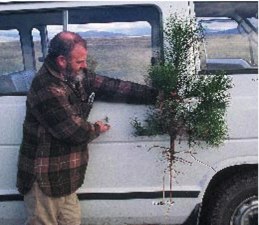Mighty mycorrhizae
Murray Davis & Nick Ledgard, New Zealand Tree Grower August 2005.
Mycorrhizae are fungi that grow in association with plant roots and assist greatly in the absorption of moisture and nutrients. In effect, they vastly increase the root surface area of plants. In forestry, as we get to know more about mycorrhizae, we continue to marvel at how important they are for the successful growth of trees. This is particularly so in harsh growing environments, such as those in dry high country.

Mycorrhizal or die
Forest Research has established a number of trials in the high country looking at mycorrhizal effects on tree establishment and growth. Basically, if the roots of young seedlings growing from seed do not become mycorrhizal within a few years of germination, they are likely to die. In one trial where the seed of three introduced pine species was inoculated with spores of the mycorrhizal fungus, Rhizopogon rubescens, it was found that inoculation not only improved early seedling survival, but also seedling size, although the latter effect was sometimes short-lived.
Seedlings grown commercially will also survive and perform much better in the field if they are inoculated with the right mycorrhizae in the nursery beds. Before this was discovered, Douglas fir seedlings planted in hill and high country were often yellow coloured and slow growing for many years after planting. This was a major reason why the species was not favoured as much as it is today.
However, this slow start became a problem of the past once it became common practice for forest nurseries to inoculate Douglas fir nursery beds with inoculum collected from healthy mature fir stands.
Behind the success of wilding conifers
The ability to rapidly form mycorrhizal relationships is also suspected to be behind the greater success of some wilding conifer species. Contorta pine has long been regarded as the most vigorous spreading species, and was the first introduced conifer to be accorded official weed status. Early trials showed that the percentage of contorta seed which germinated was no higher than for other pine species. But amongst those seedlings that did emerge, very few died – whereas other species suffered high mortality in their early years. We now believe that contorta pine seedlings were quickly developing mycorrhizal relationships with mycorrhizae, whilst other species were less capable in this respect.
With the passage of time it is likely that the levels of readily available spores of mycorrhizal fungi beneficial to conifer species are increasing. Greater numbers of young seedlings are therefore becoming mycorrhizal early in life and so surviving better and growing faster than in the past. This could well explain why Douglas fir wildings are becoming more common, whereas not so long ago it was not considered a major spreading species. Similarly, dwarf mountain pine Pinus mugo, which was rarely seen regenerating naturally in the 1970s and 80s, can be found spreading readily today.
Murray Davis and Nick Ledgard work at the Centre for Sustainable Forest Management for Ensis – the joint forces of CSIRO and SCION.

 Farm Forestry New Zealand
Farm Forestry New Zealand